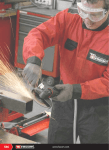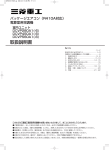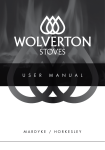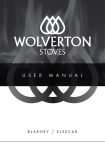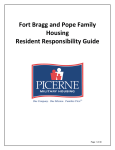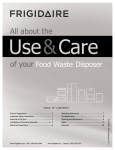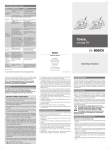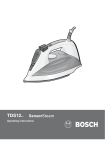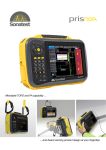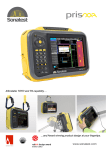Download LINEAR MANUAL new.indd
Transcript
food waste disposer installation & user manual GDBPF-370A3 GDBPF-560A1 GDBPF-750A2 GDBPF-370D LINEAR MANUAL new.indd 1 29/4/10 14:48:32 Installation & User Manual Thank you for choosing a Linear Food Waste Disposer. This product is engineered to provide many years of trouble free service. Please read this manual carefully and keep it safe for future reference. Important Notice: Before installing your Linear Food Waste Disposer, please read all of the following instructions carefully. The installation must conform to the enclosed instructions and local building regulations where applicable. Customer Service hotline: 0845 2576973 2 LINEAR MANUAL new.indd 2 29/4/10 14:48:32 Contents Introduction 4 What your food waste disposer can be used for 4 What’s included 4 Safety guide 5 Assembly drawing 6 Quick release model installation 7 Dish-washer connection 8 ABS clip model installation 9 Electrical connections 10 Air switch connection 10 Operation 11 Tips for successful operation 11 Troubleshooting 12 Cleaning and maintenance 13 Specifications 14 Contact us 15 3 LINEAR MANUAL new.indd 3 29/4/10 14:48:32 Introduction Linear food waste disposers are CE & RoHS certified. Our models have been installed across Europe, Asia, Africa and also North and South America, for over 10 years. A Linear food waste disposer is an innovative household product that will enhance any kitchen. With the potential to reduce odour, harmful bacteria and viruses caused by rotten food leftovers, in addition to reducing land-fill waste, a Linear food waste disposer really is the ideal solution for the modern kitchen. All of our units use an electric motor to grind food waste into very small pieces which can be flushed away through the sewer system and sent to the waste water treatment plant. The result is a cleaner kitchen, with no bins full of rotting food waste. What your Linear Food Waste Disposer can be used for: ✔ ✘ Food leftovers, fish bones, vegetable scraps, egg shells, tea leaves, corn cobs, small bones, vegetable peelings, nut shells etc. Plastic bags of any type or size, rope, glass, ceramics, aluminium cans, foamed plastics, big bones etc. The above list is not exhaustive and care should be taken when deciding what can be disposed of using the unit. If in doubt, please use alternative disposal method. Included in this pack: 1. Hexagon spanner 2. 3 way elbow connector 3. User Manual 4. Warranty Card Optional items: 1. Air switch 2. Extended warranty 4 LINEAR MANUAL new.indd 4 29/4/10 14:48:32 Safety Guide Please read this safety guide carefully and keep it in a safe place for future reference. Warning: This unit must be installed by a competent person in accordance with both electrical safety and building regulations, to prevent risk of fire, electrical shock or injury. 1. Read all instructions before using your food waste disposer. 2. Do not allow children, the infirm or persons with a mental disability to operate the unit. 3. Do not put fingers or hands into a Linear food waste disposer. 4. Do not put the following into a disposer: • clam or oyster shells • caustic drain cleaners or similar products • glass, china or plastic • large whole bones • metal, such as bottle caps, tin cans, aluminium foil • utensils • hot grease or other hot liquids • whole cornhusks 5. Push the air switch (if fitted) and isolate the unit from the mains power before attempting to clear a jam or remove an object from the disposer. 6. When attempting to loosen a jam in a waste disposer, use a long wooden object such as a wooden spoon – never use your fingers or metallic objects. 7. If not using the optional air switch, do not touch the disposer or on/off switch with wet hands to avoid possible electric shock. 8. When not operating the disposer, leave the stopper in place to reduce the risk of objects falling into the disposer by accident. 9. Immediately stop the machine if water leakage is detected. 5 LINEAR MANUAL new.indd 5 29/4/10 14:48:32 10. DO NOT operate disposer unless splash guard is in place. 11. The machine must be earthed and installed by a competent installer in accordance to the Electrical Safety Regulations. 12. If a problem is detected, do not operate unit again until the problem has been rectified. If in doubt, contact the customer helpline on 0845 257 6973 Assembly drawing Stopper Sink flange Sink Rubber gasket Fibre gasket Protector gasket Support ring Tapping screw Fastening ring Splashing guard Elbow flange Screws Elbow gasket Discharge elbow 6 LINEAR MANUAL new.indd 6 29/4/10 14:48:33 Installing your unit – Quick Release Model 1. Make sure that the waste pipe system has no blockage before installation. Test that the waste pipe is running clear, if not clean the pipe before continuing the installation. (figure. 1) 2. Remove the original sink waste system and drain-pipe connection, making sure to remove any marks or stains before continuing the installation. (figure. 2) 3. Remove the connector flange from the mounting ring by turning the sink flange in counter-clockwise direction until the notches align in the mount ring and allow you to pull the sink flange up and out of the remaining mounting assembly. Unpack the 3 mount screws and screw them half way through the sink flange. (figure. 3) 4. Take the stainless steel snap ring out of the groove at the end the sink flange and pull off the sink flange together with the rubber gasket, fibre gasket, triangle ring, and mount ring. Note the sequence of these parts as they are stacked. (figure. 4) 5. Make sure that your sink is clean. Place the underside rim of the rubber gasket on the sink flange (If the sink is not made of stainless steel, plumber’s putty should be used to ensure a good seal). Then, position the sink flange on the sink opening so it is centred as you look into your sink. Push the sink flange firmly into the sink opening to make a good seal. DO NOT move or rotate the sink flange once seated or the seal may be damaged. (figure. 5) 6. From under the sink, replace the fibre gasket, triangle ring and mounting ring back to the sink flange in turn. Tighten the 3 mounting screws evenly with a screwdriver. Then, put the stainless steel snap ring back to its original place. (figure. 6) 1 2 3 4 5 6 7 LINEAR MANUAL new.indd 7 29/4/10 14:48:34 7. From under the sink, while holding the sink flange firmly with one hand, line up the notches in the mount ring with the projections of the sink flange (figure 7). Make sure that the discharge outlet of the machine faces to the drain pipe. Hold the unit up to the mounting assembly, locate the notches and give the unit a 1/4 turn, so that it will hang by itself from the mounting assembly. If the assembly is difficult to twist in place, please use some lubricant like Vaseline or washing up liquid. (figure. 8) 7 8 8. Connect the discharge elbow to the unit, and make the connection to the waste system (figure. 9). After checking each connection, turn on the water tap to check that the unit is water tight. If water leakage is detected, recheck the connections and re-test until water tight. 9 Dishwasher connection If you are utilising a dishwasher, complete the following procedure: 1. Decide which connection method is more appropriate for your installation, either using the connection on the outlet elbow, or directly on the machine case. If choosing to use the direct connection to the unit case, the following procedure must be followed. 2. Using a blunt instrument (steel punch or wooden dowel), knock out entire plug. Do not use a screwdriver or sharp instrument. When knockout plug falls into disposer, you may remove it or simply leave it to be ground up when the disposer is first used. This will not damage the disposer in any way, but may take some time to grind over the course of several uses. (figure. 10) 10 11 3. Connect dishwasher hose using a jubilee clip to secure. Make sure all plumbing connections are tight and in accordance with all building regulations. Run water and check for leaks. (figure. 11) 8 LINEAR MANUAL new.indd 8 29/4/10 14:48:34 Installing your unit – ABS Clip Model NOTE: Pay close attention to the assembly sequence of mount assembly components, as they have been correctly assembled during production. 1. Remove the fastening ring by releasing the lock catch. 1 2. Remove mount assembly from disposer. 3. Unscrew support ring from sink flange and remove protector gasket and fibre gasket. You are now left with sink flange and rubber gasket. 4. The rubber gasket is used instead of plumbers putty with stainless steel sinks. Other sinks (ceramic, stone etc) will require putty. 2 5. If no putty is required, insert sink flange through rubber gasket into sink opening. Do not rotate sink flange once it is seated. 6. If using putty instead of the gasket, form a ring around the sink flange. Insert flange into sink opening, press down hard to squeeze out excess putty. From under sink, trim off excess putty flush with bottom edge of sink opening. 7. From underneath sink, slip fibre gasket onto exposed sink flange. With arrows pointing up, screw support ring onto the sink flange, hand tighten until the sink flange will not move. At this point you may want to insert stopper in sink and fill with water to check sink flange seal and insure there are no leaks. 3 4 5 8. Lift the machine up with two hands and let the sink flange insert into the splash guard and make sure that the groove on the inside of the splash guard fits over lip on sink flange. At the same time, make sure that the discharge outlet faces towards the location of the drain pipe. 9. Put the fastening ring around the splash guard and lock the buckle, checking that the installation is firm and stable. If everything is OK, go on to install the elbow and make the connection to the waste pipe. 9 LINEAR MANUAL new.indd 9 29/4/10 14:48:34 Electrical connections 1. The electrical installation must be carried out by a competent installer, in accordance with electrical & building regulations. The unit comes with a standard BS plug, although this can be discarded and a fused spur used if preferred. 2. A separate on/off switch should be provided on the circuit when the optional air switch is not used. This switch should be a minimum IP44 rated, and installed at least the minimum distance from the sink as stipulated in the Electrical Installation Regulations. 3. The unit must be earthed. 4. After the successful installation, ensure that the “Reset” button should be in the position which is easy to reach. 5. If the power cord becomes damaged, please contact the helpline to arrange specialist repair or replacement. Air switch connection Step one Rotate the locking nut in a counter-clockwise direction until it is removed. Step two Put the end of the air switch pipe through the locking nut. Step three Put the end of the air switch pipe into the connection point and ensure it is snug over the nipple. Step four Slide the locking nut over and rotate in a clockwise direction until the connection is tight. The installation is finished. 10 LINEAR MANUAL new.indd 10 29/4/10 14:48:34 How to operate your food waste disposer 1. Remove sink stopper. Turn on a medium flow of cold water. 2. Push the air switch button or on/off switch (depending upon installation); your motor is turning at full speed and ready to use. 3. Drop in food waste. The disposer motor may slow down while grinding, this is perfectly normal as the disposer is actually increasing torque (grinding power) and is operating under normal conditions. 4. Before turning disposer off, let water and disposer run for approximately 15 seconds after disposal stops. This assures that all waste is thoroughly flushed through trap and waste pipe. 5. It is not recommended to use hot water while running the unit. Cold water will keep waste and fats solid so disposer can flush away particles. Tips for successful operation 1. Make sure that the unit is empty before using your dishwasher, this will ensure that the dishwasher drains properly. 2. You may want to leave the stopper in the drain when not in use to prevent utensils and foreign objects from falling into the disposer. 3. Your disposer is ruggedly built to give you many years of trouble free service. It will handle all normal food wastes, but it will NOT grind or dispose of such items as plastic, tin cans, bottle caps, glass, china, leather, cloth, rubber, string, clam and oyster shells, aluminium foil or feathers. 11 LINEAR MANUAL new.indd 11 29/4/10 14:48:34 Troubleshooting Before seeking repair or replacement, please review the following: Phenomenon Possible reason and action Loud noise (Other than those during grinding of small bones and fruit stones/pips): These are usually caused by accidental entry of a spoon, bottle cap or other foreign object. To correct this, turn off unit and isolate electrical power. After unit has stopped, remove splash guard, remove object with long handled tongs, and replace splash guard. Unit does not start Unplug power cord or turn either the wall switch or breaker box switch to “OFF” position, or push the air switch, depending on your model and wiring configuration. Remove stopper and/or splash guard. Check to see if turntable will rotate freely using a wooden spoon handle. If turntable rotates freely, replace splash guard and check re-set button to see if it has been tripped. Re-set button is red and located at the bottom of the machine. Push button in until it clicks and remains depressed. If re-set button has not been tripped, consult a qualified electrical engineer to check for shorted or broken connections, electrical power switch, fuse box and circuit breaker. If wiring and electrical components are intact, the unit may have internal problems that require service or replacement in which case contact the customer helpline. If turntable does not rotate freely Turn off disposer, then check for any foreign object lodged between the turntable and grinding ring. Dislodge object by rotating table with a wooden spoon handle and remove object. If no foreign object is present, there may be internal problems in which case contact the customer helpline. Leaks If the unit leaks at the top, it may be due to: 1. Improper seating of sink flange (gasket centring, putty or tightening). 2. Support ring not tightened properly. 3. Defective or improperly installed splash guard. If unit leaks at the waste elbow, leak may be due to improper tightening of elbow flange screws. 12 LINEAR MANUAL new.indd 12 29/4/10 14:48:34 Cleaning and maintenance I) Do not attempt to lubricate your disposer. The motor is permanently lubricated. The disposer is self cleaning with each use. NEVER put chemical drain cleaners into the disposer, as they cause serious corrosion of metal parts. If used, resulting damage is easily detected and all warranties are void. Mineral deposits from your water can form on the stainless steel turntable, giving the appearance of rust. DO NOT BE ALARMED, the stainless steel turntables used will not corrode and can be cleaned with specialist cleaner such as ‘Bar Keepers Friend’. II) How to use the Reset button. 1. Pull the plug out from the socket to cut off power source. 2. If the blockage is caused by very hard objects such as metals, ceramics, nylon products and so on, use long tweezers to pick them up, if not use long wooden objects, for example a wooden spoon, to move the cutter head to the right and left. 3. Insert one end of a hex-key into the centre hole at the bottom of the machine and turn it to the right and left till it can revolve freely. 4. Press down the red reset button. When the motor is blocked by some objects, the Overload Protection System will trip to protect the motor. The Reset button will pop up at once and the machine will stop automatically. 5. Insert the plug back into the socket to supply power again and the machine can be used normally. Marks caused by deposits or scale on the cutter head are normal after use. The inner components and surfaces of the food waste disposer is made up of corrosion-proof materials. 13 LINEAR MANUAL new.indd 13 29/4/10 14:48:34 Specifications Motor DC motor AC motor BPF-370 BPF-370 BPF-560 BPF-750 BPF-750 Size D A3 A1 A1 A2 A 325.5 325.5 325.5 362 362 B 172 172 172 186 186 C 182 182 182 191 191 D 114 114 114 114 114 model C D B A 14 LINEAR MANUAL new.indd 14 29/4/10 14:48:34 Contact us Distributor GM Distribution Address 70 High Park Drive Mill Park Industrial Estate Old Wolverton Mill East Milton Keynes Post code MK12 5TT Phone number 0845 257 6973 Fax number 0845 257 6975 Web site www.graftondistribution.co.uk Email [email protected] 15 LINEAR MANUAL new.indd 15 29/4/10 14:48:34 LINEAR MANUAL new.indd 16 29/4/10 14:48:34
















